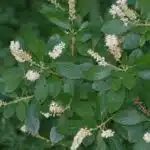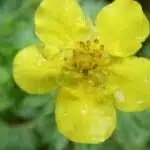As a horticultural expert, I have found that many people express a desire to grow plants that are not only beautiful but also have practical uses. One such plant is the New Jersey Tea, also known as the Mountain Snowbell. This valuable shrub has been used for centuries for medicinal purposes and can be grown at home with ease.
Native to North America, the New Jersey Tea is a hardy plant that can survive in a variety of soil types and climates. It is especially useful for those who live in colder regions as it can tolerate temperatures as low as -40°F. In addition to its practical uses, the shrub boasts beautiful white flowers that bloom in late spring and attract pollinators such as bees and butterflies. In this article, we will discuss how to successfully grow New Jersey Tea in your own backyard while reaping its numerous benefits.
Introduction To The New Jersey Tea
New Jersey Tea, also known as Mountain Snowbell, is a deciduous shrub that is native to North America. It belongs to the family Rhamnaceae and can grow up to 3-4 feet in height. The plant has woody stems and green leaves that are lance-shaped with fine serrations along the edges. In early summer, it produces small white flowers in clusters at the tip of the branches.
Apart from being a beautiful ornamental shrub, New Jersey Tea has been used for medicinal purposes by Native Americans for centuries. The plant’s roots were boiled and consumed as tea to treat various ailments such as diarrhea, dysentery, and sore throats. The leaves were also made into a poultice to alleviate pain and swelling caused by insect bites and stings.
The medicinal properties of New Jersey Tea have been attributed to its high content of tannins and flavonoids. These compounds have anti-inflammatory, analgesic, and antiseptic properties that make it an effective natural remedy for certain health conditions. As such, New Jersey Tea has gained popularity among herbalists and alternative medicine practitioners who incorporate it into their treatments for various ailments.
Understanding the characteristics of this plant is crucial for successful growth and cultivation. Let us delve deeper into its growing requirements and how to care for it properly.
Understanding The Plant’s Characteristics
New Jersey tea, also known as mountain snowbell, is a hardy shrub that belongs to the buckthorn family. This plant is native to eastern North America and grows best in USDA hardiness zones 4 to 8. Understanding growth patterns and soil requirements can help you successfully cultivate this plant.
Understanding growth patterns is essential when growing New Jersey tea. This shrub often grows up to three feet tall and three feet wide, with an upright habit. It has a slow-to-moderate growth rate, taking several years to reach maturity. Pruning can help shape the plant and promote bushier growth. New Jersey tea blooms in late spring or early summer with small white flowers that grow in clusters.
Soil requirements for New Jersey tea are specific but not difficult to meet. This shrub prefers well-draining soil that is slightly acidic with a pH of 5.5 to 7.0. It can tolerate a range of soils, including sandy or clay soils, as long as they are well-draining. However, it does not do well in wet or poorly drained soil. Amending the soil with organic matter like compost or aged manure before planting can improve drainage and fertility.
To ensure success when growing New Jersey tea, understanding its growth patterns and soil requirements is crucial. By providing the right conditions for this hardy shrub, you will be rewarded with beautiful white blooms and attractive foliage year after year. In the next section, we will discuss how to choose the right location for your New Jersey tea plant.
Choosing The Right Location For Your New Jersey Tea
Understanding the plant’s characteristics is crucial when it comes to growing New Jersey tea or mountain snowbell. This plant thrives in full sun and well-drained, sandy soil. In terms of appearance, New Jersey tea is a deciduous shrub that can grow up to 3 feet tall and wide. It has dark green leaves and produces small white flowers that bloom from June to August.
To grow New Jersey tea successfully, choosing the right location is essential. As mentioned earlier, this plant requires full sun exposure for optimal growth. Therefore, it is recommended to select a spot in your garden where it will receive at least 6 hours of direct sunlight daily. Moreover, ensure that the area you choose has well-drained soil as New Jersey tea does not tolerate soggy or waterlogged conditions.
The ideal soil for planting New Jersey tea should be slightly acidic with a pH range of 5.5 to 6.5. Additionally, it should have good drainage capacity and contain organic matter like compost or peat moss which helps retain moisture and nutrients in the soil. Before planting, prepare the soil by removing weeds and rocks from the area and tilling the ground to loosen compacted soil. Adding organic matter will improve the overall quality of your soil and provide nutrients that your plants need to thrive.
Preparing The Soil For Planting
To achieve a successful growth of New Jersey tea, soil preparation is a vital process. It is essential to have well-drained soil that can hold moisture and nutrients to support plant growth. The ideal pH range for growing New Jersey tea ranges from 4.0 to 6.5, which is acidic to slightly acidic.
Soil testing is a crucial step before planting any crop in your garden or farm. You can collect a sample of your soil and send it to a laboratory for analysis. Soil testing will help you determine the nutrient content, pH level, and organic matter in your soil. Based on the results of the test, you can then add amendments such as compost, manures, or lime to adjust the pH levels and improve soil fertility.
Here are five tips for preparing your soil for planting New Jersey tea:
- Remove all weeds and debris from the planting site.
- Loosen the top layer of soil using a rake or tiller.
- Mix in organic matter such as compost or well-aged manure into the topsoil.
- Add lime if needed to adjust the pH level according to the results of your soil test.
- Incorporate slow-release fertilizer into the soil before planting.
With proper soil preparation, you can create an optimal growing environment for your New Jersey tea plants. Once you have completed this step, it’s time to move onto selecting the right time to plant these beautiful shrubs.
Selecting The Right Time To Plant
After preparing the soil for planting, it is essential to select the right time to plant your new jersey tea. The best practices for planting this shrub are during the fall or spring seasons when temperatures are mild and consistent. During these seasons, the root system of your new jersey tea can establish itself in the soil without being exposed to extreme heat or cold.
Common mistakes when selecting the time for planting your new jersey tea include choosing a season with inconsistent weather patterns, such as summer or winter. These seasons can cause stress on your shrub’s root system, leading to stunted growth and an overall weaker plant. Additionally, avoid planting during periods of heavy rainfall or drought, as excessive moisture or lack thereof can also harm your new jersey tea.
When you have selected the right time for planting your new jersey tea and have prepared the soil appropriately, it is crucial to ensure that you provide adequate care for your shrub throughout its growth period. This includes regular watering, pruning dead branches, and fertilizing with a balanced fertilizer once every year. Following these best practices will help ensure that your new jersey tea grows healthy and strong throughout its lifespan.
Planting Your New Jersey Tea
It is ironic that the New Jersey Tea (mountain snowbell) is not even native to New Jersey, but rather to the American Midwest. However, it has found a home in gardens across the country for its lovely white flowers and ability to attract beneficial insects. If you are interested in adding this plant to your garden, here are some tips on how to plant it successfully.
First, consider container gardening if you have limited space or poor soil quality. A pot that is at least 12 inches deep and wide will provide enough room for the roots to grow. Fill it with well-draining soil that is rich in organic matter. Alternatively, if planting directly into the ground, choose a spot that receives full sun or partial shade and make sure the soil is well-drained.
Secondly, consider companion planting with other species such as coneflowers or bee balm. These plants attract pollinators that will also visit your New Jersey Tea and increase its chances of producing fruit. Additionally, they deter harmful insects from attacking your tea plant.
Lastly, when planting make sure to space each seedling about 2-3 feet apart. This allows each plant adequate room for growth without competing for resources such as water and nutrients. With proper care and attention, your New Jersey Tea will thrive in its new environment and provide a beautiful addition to your garden.
To ensure your New Jersey Tea stays healthy and vibrant throughout its growing season, proper watering and fertilization is key.
Watering And Fertilizing Your Plant
Proper watering is crucial in growing New Jersey Tea. This plant requires moderate watering, with the frequency decreasing during winter months. Overwatering can lead to root rot and other fungal diseases, so it’s important not to leave the soil too wet. A good rule of thumb is to water your New Jersey Tea every 7-10 days during the growing season, ensuring that the soil is moist but never saturated.
Fertilizing your New Jersey Tea can promote healthy growth and vibrant blooms. Organic fertilizers are ideal for this plant since they release nutrients gradually without burning the roots. Compost and aged manure are excellent choices as they provide a balanced mix of essential minerals and micronutrients. Fertilize your New Jersey Tea in early spring before new growth begins, and again in mid-summer to encourage a second flush of flowers.
By following proper watering and fertilization techniques, you’ll have a healthy and thriving New Jersey Tea plant. However, pruning and maintaining your plant is equally important in ensuring its longevity. In the next section, we will discuss how to properly prune and care for your New Jersey Tea to keep it looking its best year after year.
Pruning And Maintaining Your New Jersey Tea
Pruning is an important part of maintaining a healthy New Jersey Tea, as it helps to maintain the desired shape and size, as well as encourages new growth. Maintaining the soil conditions and providing adequate sunlight, water and fertilizer is essential for a healthy and vigorous plant. Mulching around the base of the plant is also important in helping to retain moisture and prevent weeds. Pruning strategies should also be considered, such as deadheading and training, to help reinvigorate the plant and prevent pests and diseases.
Pruning
Proper pruning is essential in maintaining the health and beauty of your New Jersey tea plant. Pruning should be done annually in late winter or early spring before new growth appears. The benefits of pruning include promoting better air circulation, increasing sunlight exposure to lower parts of the plant, stimulating new growth, and maintaining an overall tidy appearance.
One common mistake in pruning techniques is over-pruning. This can lead to weaker branches that are more prone to breakage and disease. Another mistake is not pruning enough, which can result in a dense and overcrowded plant that inhibits proper air circulation and sunlight exposure. It’s important to strike a balance between these two extremes and prune only as much as necessary to maintain the plant’s health and shape.
When pruning your New Jersey tea, be sure to use sharp, clean tools to avoid damaging the plant or spreading disease. Remove any dead, damaged or diseased wood first, then focus on shaping the plant by selectively removing unwanted or crossing branches. Always make cuts just above a healthy bud or branch junction and avoid leaving stubs. With proper pruning techniques, your New Jersey tea will thrive for years to come.
Maintaining
After properly pruning your New Jersey tea plant, it is important to continue maintaining it throughout the growing season. Common issues that may arise include pests, diseases, and nutrient deficiencies. It is important to identify these problems early on and take appropriate action to prevent them from spreading.
One troubleshooting technique is to regularly inspect the plant for any signs of damage or discoloration. If you notice any abnormalities, take a closer look and try to identify the source of the problem. For example, if you see small holes in the leaves, this may indicate an infestation of caterpillars or other insects. In this case, you can remove them by hand or use an insecticide spray.
Another way to maintain your New Jersey tea plant is to provide it with adequate nutrition. This can be accomplished by adding organic matter such as compost or manure around the base of the plant. Additionally, you can apply a balanced fertilizer according to package instructions. By following these tips and techniques for maintaining your New Jersey tea plant, you can ensure that it remains healthy and beautiful for years to come.
Dealing With Pests And Diseases
As with any plant, New Jersey Tea is vulnerable to pests and diseases. To ensure a healthy growth, it is imperative to take preventive measures and keep an eye on the plant for any signs of distress. One of the most common problems faced by New Jersey Tea is leaf spot caused by fungi. This can be treated by removing affected leaves or spraying with organic remedies such as neem oil or copper fungicide.
Another common pest that attacks New Jersey Tea is spider mites. These small insects feed on the sap of the plant, causing leaves to turn yellow and drop off prematurely. Preventive measures include keeping the plant well-watered and ensuring good air circulation around it. If spider mites do appear, spraying with organic remedies such as insecticidal soap or garlic spray can help eliminate them.
Caterpillars are also known to attack New Jersey Tea, eating holes in the leaves and causing significant damage. Handpicking caterpillars off the plant is an effective way to control their population. For larger infestations, spraying with organic remedies such as Bacillus thuringiensis (BT) can help control caterpillar populations without harming beneficial insects such as bees and butterflies. By taking preventive measures and using organic remedies when necessary, you can ensure a healthy and bountiful harvest of New Jersey Tea leaves.
Moving on from dealing with pests and diseases, harvesting and using the leaves requires careful attention to detail to maintain their potency and flavor.
Harvesting And Using The Leaves
To ensure that your New Jersey Tea (Mountain Snowbell) is healthy and thriving, it is important to keep an eye out for possible pests or diseases that may affect its growth. Some common pests that may attack this plant are aphids, spider mites, and leafhoppers. In addition, powdery mildew can also be a problem if the plant is exposed to high humidity levels or poor air circulation. To prevent these issues, make sure to maintain good hygiene practices in your garden area and remove any infected leaves or branches.
Once your New Jersey Tea has reached maturity, it is time to start harvesting its leaves. The best time to do this is during the early morning when the leaves are at their freshest. Remove only the top few inches of growth from each stem using a sharp pair of scissors or pruning shears. After harvesting, be sure to dry the leaves properly before using them in tea recipes. There are several drying methods you can use such as air-drying or using a dehydrator.
When it comes to making tea from New Jersey Tea (Mountain Snowbell), there are many delicious recipes you can try. One popular option is to mix dried New Jersey Tea leaves with other herbs such as mint or chamomile for a refreshing blend that can be enjoyed hot or cold. Another recipe involves steeping the dried leaves in boiling water for several minutes before adding honey or lemon for added flavor. Experiment with different combinations until you find your perfect cup of tea!
As you move on to harvesting and using the flowers of your New Jersey Tea (Mountain Snowbell), it is important to remember that they should only be picked once they have fully bloomed. Look for flowers that have opened completely and gently pluck them from the stem without damaging any surrounding foliage. Once harvested, the flowers can be used fresh in arrangements or dried for use in teas and other culinary creations.
Harvesting And Using The Flowers
The delicate white flowers of the New Jersey tea plant are a sight to behold. With their snow-white petals and yellow centers, they appear as though they have just been dusted with powdered sugar. These lovely blooms not only add beauty to any garden, but they also possess a number of medicinal properties.
To harvest the flowers, wait until they have fully bloomed before snipping them off with scissors or pruning shears. It’s important to handle them gently so as not to damage the delicate petals. Once harvested, you can use a variety of drying techniques such as air-drying, oven-drying, or using a dehydrator. Whichever method you choose, be sure to store your dried flowers in an airtight container away from sunlight and moisture.
New Jersey tea flowers have long been known for their medicinal properties. They contain high levels of tannins which makes them useful for treating diarrhea and other digestive issues. Additionally, the flowers possess anti-inflammatory and antiseptic properties which make them helpful in treating skin irritations such as eczema and psoriasis. When used medicinally, it’s important to consult with a healthcare professional beforehand.
Moving onto harvesting and using the roots of the New Jersey tea plant…
Harvesting And Using The Roots
After harvesting the flowers of New Jersey Tea, it’s time to move on to harvesting the roots. The best time to harvest the roots is in the early spring or late fall when the plant is dormant. It’s important to note that New Jersey Tea has a long taproot that can go down up to 3 feet deep. Therefore, using a digging fork is recommended as it won’t damage the taproot.
When harvesting New Jersey Tea roots, it’s important to dig around the plant and gently loosen the soil. Once you have done this, grasp the plant at its base and pull gently to remove it from the ground. You can then shake off any loose soil and trim away any damaged or diseased parts of the root. Be sure to wash the roots thoroughly before storing them in a cool, dry place.
The medicinal uses of New Jersey Tea roots are not as well-known as those of its leaves and flowers. However, they still contain certain properties that make them beneficial for treating different ailments. The root can be brewed into a tea that helps with digestive issues such as diarrhea and constipation. It can also be used as a poultice for wounds, bruises, and skin infections due to its antimicrobial properties. Overall, New Jersey Tea roots are an excellent addition to your herbal medicine cabinet.
Moving on from harvesting and using both flowers and roots, let’s explore some creative ways you can use New Jersey Tea in your everyday life.
Creative Ways To Use New Jersey Tea
New Jersey tea, also known as mountain snowbell, is a versatile plant that can be used in various ways. Its delicate white flowers and glossy green leaves make it an attractive addition to any garden or landscape. The plant has a natural appeal that can brighten up any space, and its fragrance is both calming and refreshing.
There are several creative ways to use New Jersey tea. Here are three ideas to consider:
Tea: As the name implies, New Jersey tea can be steeped in hot water to create a delicious and refreshing tea that has a unique flavor profile. The subtle sweetness of the leaves is complemented by a slightly bitter aftertaste that gives the tea its distinctive character.
Salad Dressing: The leaves of New Jersey tea can be finely chopped and added to salad dressings for an extra burst of flavor. They add a fresh, herbal taste that pairs well with citrus fruits like lemon or orange.
Medicinal Applications: New Jersey tea has been used for centuries for its medicinal properties. It is believed to have anti-inflammatory effects and may help relieve respiratory ailments like coughs and bronchitis.
New Jersey tea is not only beautiful but also beneficial to health. Its culinary applications are numerous, and its medicinal properties make it a valuable addition to any herb garden. In the next section, we will explore some tips for successful growing so you too can enjoy this versatile plant at home!
Tips For Successful Growing
Successful growing of New Jersey Tea requires careful attention to the plant’s specific needs. Propagation methods involve sowing seeds in well-draining soil, preferably with a pH value between 4.5 and 6.0. The ideal time for planting is during early spring, and it is essential to maintain a moist environment throughout the germination process.
One of the most common mistakes that gardeners make when growing New Jersey Tea is overwatering. This plant prefers dry soil and can quickly rot if watered too often or excessively. Additionally, it thrives in full sun exposure but may also tolerate partial shade, making it an excellent choice for gardens with varying light conditions.
To ensure successful growth of New Jersey Tea, pruning should be done regularly to stimulate new growth and help maintain its shape. Deadheading spent flowers can also encourage further bloom production. As an added benefit, this plant attracts pollinators such as bees and butterflies, making it a valuable addition to any garden.
Growing New Jersey Tea can be a rewarding experience when done correctly. By following proper propagation methods, avoiding common mistakes such as overwatering, and maintaining regular pruning practices, you can enjoy the benefits of this beautiful plant in your garden for years to come. In the subsequent section about conclusion: enjoying the benefits of your New Jersey tea, we will explore different ways in which you can utilize this versatile plant for both medicinal and decorative purposes.
Conclusion: Enjoying The Benefits Of Your New Jersey Tea
As you sit on your porch or balcony, sipping on a cup of freshly brewed tea, imagine that the warm, comforting feeling it brings is just like the feeling you get from growing and caring for your New Jersey Tea plant. Just as you carefully tended to your plant, allowing it to thrive and flourish, so too does it provide you with its own benefits.
Health benefits: Drinking New Jersey Tea is not only a tasty experience but also a healthy one. This tea is rich in antioxidants that help boost the immune system and reduce inflammation. Furthermore, it can aid in digestion and help relieve stress and anxiety.
Culinary uses: The leaves of the New Jersey Tea plant can be used as a substitute for traditional tea leaves, providing a unique flavor profile to your typical cup of tea. Additionally, they can be used in cooking as an herb to add flavor to soups or stews. The roots of this plant can also be dried and ground into a powder that can be used as a coffee substitute.
Incorporating New Jersey Tea into your life not only adds beauty to your garden but also provides various health benefits and culinary uses. As you continue to care for this beautiful plant over time, remember to appreciate all that it has to offer in return.
Conclusion
New Jersey Tea, also known as Mountain Snowbell, is a versatile plant that can be grown in a variety of climates and soil types. This article has provided an overview of how to successfully grow this plant, covering topics such as understanding its characteristics, choosing the right location and preparing the soil for planting. Additionally, we have discussed the importance of selecting the right time to plant and harvesting and using the roots for medicinal purposes.
One interesting statistic to note is that New Jersey Tea was commonly used during the American Revolution as a tea substitute due to its high tannin content. This fact creates imagery in the mind of readers, imagining soldiers brewing up cups of New Jersey Tea on cold winter nights in order to keep warm and energized.
By following the tips outlined in this article, gardeners can enjoy growing their own New Jersey Tea plants and reaping the benefits of this versatile plant. From creating natural dyes to making medicinal teas, there are many creative ways to use this unique plant. With proper care and attention, your New Jersey Tea plants will thrive and provide enjoyment for years to come.
Image Credits
- “Michael Johns Addresses Pre-Election Tea Party, Morristown, New Jersey, November 1, 2009” by michaeldjohns (featured)





























